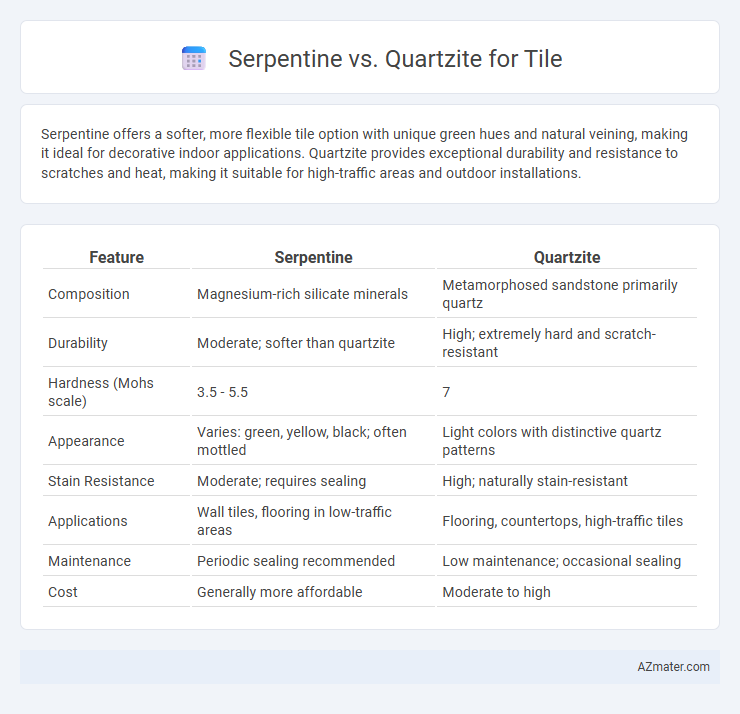Serpentine offers a softer, more flexible tile option with unique green hues and natural veining, making it ideal for decorative indoor applications. Quartzite provides exceptional durability and resistance to scratches and heat, making it suitable for high-traffic areas and outdoor installations.
Table of Comparison
| Feature | Serpentine | Quartzite |
|---|---|---|
| Composition | Magnesium-rich silicate minerals | Metamorphosed sandstone primarily quartz |
| Durability | Moderate; softer than quartzite | High; extremely hard and scratch-resistant |
| Hardness (Mohs scale) | 3.5 - 5.5 | 7 |
| Appearance | Varies: green, yellow, black; often mottled | Light colors with distinctive quartz patterns |
| Stain Resistance | Moderate; requires sealing | High; naturally stain-resistant |
| Applications | Wall tiles, flooring in low-traffic areas | Flooring, countertops, high-traffic tiles |
| Maintenance | Periodic sealing recommended | Low maintenance; occasional sealing |
| Cost | Generally more affordable | Moderate to high |
Understanding Serpentine and Quartzite
Serpentine and quartzite are popular natural stones used for tile, each with distinctive geological properties and aesthetics. Serpentine is a metamorphic rock known for its unique greenish hues and smooth, often waxy texture, making it attractive for interiors requiring a softer, more varied visual appeal. Quartzite, a hard metamorphic rock predominantly composed of quartz, offers superior durability and a more consistent granular appearance, ideal for high-traffic areas demanding resilience and a polished look.
Composition and Formation Differences
Serpentine tiles consist primarily of serpentine group minerals, formed through the hydration and metamorphic transformation of ultramafic rocks, resulting in a softer, often green-hued stone with a smooth texture. Quartzite is a metamorphic rock derived from sandstone subjected to high heat and pressure, composed almost entirely of recrystallized quartz grains, creating a dense, hard, and highly durable tile with a glassy luster. The fundamental difference lies in serpentine's mineralogy and formation from ultramafic origins versus quartzite's quartz-dominated composition formed from quartz-rich sandstone protoliths.
Appearance and Color Variations
Serpentine tiles showcase a rich palette of deep greens, often interspersed with black or gold veining, creating a luxurious and earthy aesthetic. Quartzite tiles exhibit a wider spectrum of colors, ranging from soft grays and whites to subtle blues and pinks, featuring more linear, crystalline patterns that offer a sleek and modern appearance. The distinctive swirling patterns of serpentine contrast with quartzite's often more uniform, granular texture, making each choice ideal for different design themes and styles.
Durability and Hardness Comparison
Serpentine tiles offer moderate durability with a Mohs hardness of 3 to 5, making them suitable for low-traffic areas but prone to scratches and etching. Quartzite tiles possess superior hardness, ranging from 7 to 8 on the Mohs scale, providing exceptional resistance to wear, abrasion, and impact, ideal for high-traffic and heavy-use spaces. The significant difference in hardness between Serpentine and Quartzite directly influences their longevity and maintenance requirements in tile applications.
Resistance to Stains and Chemicals
Serpentine tiles exhibit moderate resistance to stains and chemicals but are more susceptible to etching and discoloration when exposed to acidic substances compared to quartzite. Quartzite offers superior resistance to staining and chemical damage due to its dense, non-porous structure and high quartz content, making it ideal for high-traffic or kitchen areas. Proper sealing enhances the stain and chemical resistance of both serpentine and quartzite, but quartzite generally maintains its durability longer under harsh conditions.
Maintenance and Cleaning Requirements
Serpentine tiles require regular sealing to prevent staining and are more prone to etching from acidic cleaners, making maintenance more intensive compared to quartzite. Quartzite tiles offer superior durability and resistance to scratches and etching, requiring less frequent sealing and allowing for easier cleaning with mild detergents. Both materials benefit from prompt spill cleanup, but quartzite's hardness results in lower maintenance demands in high-traffic areas.
Installation Considerations for Each Stone
Serpentine tiles require careful sealing before and after installation due to their moderate porosity and susceptibility to staining, making moisture barriers essential in wet areas. Quartzite tiles are denser and harder, allowing for easier cutting and polishing, but their hardness demands diamond-tipped tools and professional installation to avoid chipping and ensure proper joint alignment. Both stones benefit from stable substrates and flexible adhesives to accommodate their natural expansion and prevent cracking over time.
Cost Differences: Serpentine vs Quartzite
Serpentine tiles generally cost less than quartzite tiles due to lower quarrying and processing expenses. Quartzite, known for its hardness and durability, commands a higher price, often ranging from $70 to $120 per square foot compared to serpentine's $40 to $60 per square foot. The significant cost difference is influenced by the rarity and strength of quartzite, making serpentine a budget-friendly alternative for tile applications.
Ideal Applications for Serpentine vs Quartzite Tiles
Serpentine tiles are ideal for indoor applications such as bathroom floors, kitchen backsplashes, and wall cladding due to their rich green hues and moderate durability, offering a smooth finish that resists water absorption. Quartzite tiles, with superior hardness and abrasion resistance, excel in high-traffic areas like commercial flooring, outdoor patios, and stair treads, providing long-lasting performance and natural stone aesthetics. Both stones offer unique visual appeal and functional benefits, with serpentine favored for decorative, low-impact uses, while quartzite supports robust, heavy-duty applications.
Pros and Cons: Making the Right Choice
Serpentine offers unique green hues and excellent resistance to heat and moisture, making it suitable for bathroom and kitchen tiles, but it is softer and more prone to scratches compared to quartzite. Quartzite provides superior hardness and durability, ideal for high-traffic areas and outdoor use, yet it often requires more maintenance due to its susceptibility to etching and staining. Choosing between serpentine and quartzite depends on balancing aesthetic preferences, the tile's functional requirements, and maintenance willingness.

Infographic: Serpentine vs Quartzite for Tile
 azmater.com
azmater.com